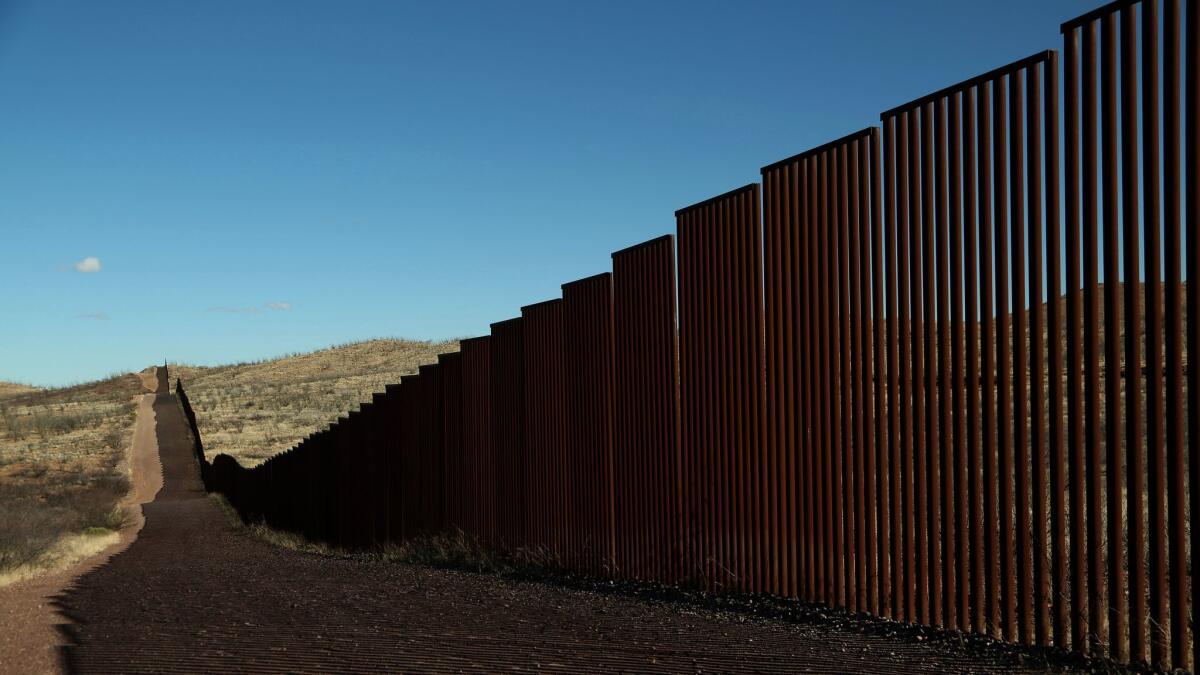Editorial: Pretty much the only thing Trump’s border wall will block is common sense

The Trump administration is accepting proposals from contractors for preliminary designs and prototypes for the first sections of the president’s ballyhooed wall along the border with Mexico. If it’s built, the project will be a boondoggle of legendary proportions and likely will become the subject of historic ridicule. Why? Because Trump’s silly wall can’t possibly address much of the problem he seeks to fix.
It’s hard to count people hiding in the shadows, but the best estimates put the current U.S. population of undocumented immigrants at 11 million to 12 million people. The Pew Research Center reports that a long growth trend in illegal immigration began around 1990, when the undocumented population was about 3.5 million, then rose steadily to a peak of 12.2 million in 2007 and since has ebbed to a stable 11.7 million people. But those folks, obviously enough, are already here — about three-quarters of them have lived in the U.S. for more than a decade, and only 14% have been here for less than five years. Our undocumented neighbors are not newcomers.
Pew says net illegal immigration has shifted in recent years, with more Mexicans leaving the country than entering, a function of the U.S. economy’s slow recovery from the 2007-2009 recession and improved job opportunities in Mexico. The Border Patrol similarly has charted a decrease in apprehensions along the Mexican border, from an average of 1.16 million a year between 2000 and 2006, to 858,638 in 2007, bottoming out at 327,577 in 2011. Driven partly by an influx of Central American children and families, who tend to turn themselves in upon arrival to seek asylum, apprehensions rebounded to 408,870 last year. Given that diminished human flow, and the fact that more people are leaving than arriving, it hardly seems worth the expense of building a wall that the Department of Homeland Security estimated would cost $21.6 billion (other estimates run much higher).
Human migration routes are like rivers: If they hit an obstacle, the flow finds a way around it.
Trump has milked the melodrama of a border wall, but he ignores the likelihood that it would be ineffectual at stopping people from entering the country without permission. Human migration routes are like rivers: If they hit an obstacle, the flow finds a way around it. So a wall will just lead smugglers to find new routes and methods — planes, boats and 31-foot ladders for a 30-foot wall — even as it is being built, further undercutting confidence in the barrier’s effectiveness. Nor would Trump’s wall address the growth in illegal immigration from Asia, which outpaces immigration from Latin America.
Perhaps most important, a wall could do nothing to halt the growing trend of people entering the country legally (often by plane) and then not leaving, which by some estimates accounts for as much as half of the undocumented immigration.
Granted, ending overstays is a tricky problem. The government already records who enters the country, including collecting fingerprints from non-citizens. But it has yet to figure out a way to know when those visitors leave. Congress ordered an “entry-exit” system in the 1996 Illegal Immigration Reform and Immigrant Responsibility Act, and renewed the call after the 9/11 terror attacks — at least five of the terrorists had expired visas. But implementing it has proved vexingly difficult, and the Clinton, Bush and Obama administrations all failed to come up with a workable system despite spending $600 million on pilot projects.
While collecting biometric information might be relatively simple at international airport terminals, the challenges become monumental at ground-level crossings, where some 119 million people leave the country each year without any interaction with U.S. Border Patrol (travelers do get interviewed by Mexican and Canadian border agents as they enter those countries). So the U.S. would have to build checkpoints at each crossing, many of which lack the space for that kind of expansion, and would make authorized border-crossing even more time-consuming and frustrating. It also would be expensive — about $7 billion. Then the government would need to create or expand programs to match the departures against the entries, figure out who has overstayed and track them down.
At some point, the government needs to get honest about what is possible, and what is desirable, in addressing illegal immigration. And taxpayers need to decide how much they’re willing to spend for what result, and where the line between reasonable and ridiculous might lie.
Follow the Opinion section on Twitter @latimesopinion or Facebook
Click here for a Spanish version of this story
MORE FROM OPINION
It’s not Neil Gorsuch’s fault, but we can’t support his ascension to a stolen Supreme Court seat
Trump discovers that legislating is complicated as the GOP healthcare bill goes down in flames
Keystone Pipeline and other Trump energy policies could help swamp Mar-a-Lago
More to Read
A cure for the common opinion
Get thought-provoking perspectives with our weekly newsletter.
You may occasionally receive promotional content from the Los Angeles Times.










